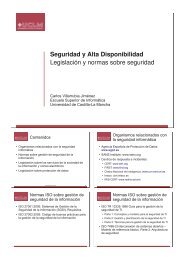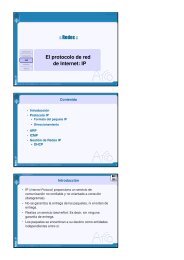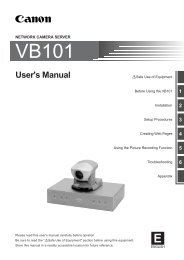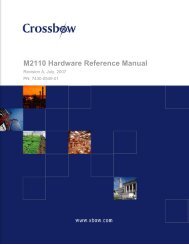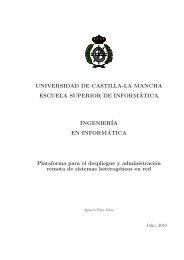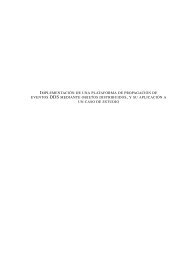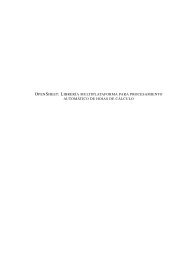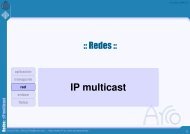Pensar en C++ (Volumen 1) - Grupo ARCO
Pensar en C++ (Volumen 1) - Grupo ARCO
Pensar en C++ (Volumen 1) - Grupo ARCO
You also want an ePaper? Increase the reach of your titles
YUMPU automatically turns print PDFs into web optimized ePapers that Google loves.
✐<br />
✐<br />
✐<br />
“Volum<strong>en</strong>1” — 2012/1/12 — 13:52 — page 293 — #331<br />
✐<br />
10.3. Miembros estáticos <strong>en</strong> <strong>C++</strong><br />
//: C10:StaticMemberFunctions.cpp<br />
class X {<br />
int i;<br />
static int j;<br />
public:<br />
X(int ii = 0) : i(ii) {<br />
// Non-static member function can access<br />
// static member function or data:<br />
j = i;<br />
}<br />
int val() const { return i; }<br />
static int incr() {<br />
//! i++; // Error: static member function<br />
// cannot access non-static member data<br />
return ++j;<br />
}<br />
static int f() {<br />
//! val(); // Error: static member function<br />
// cannot access non-static member function<br />
return incr(); // OK -- calls static<br />
}<br />
};<br />
int X::j = 0;<br />
int main() {<br />
X x;<br />
X* xp = &x;<br />
x.f();<br />
xp->f();<br />
X::f(); // Only works with static members<br />
} ///:~<br />
Puesto que no ti<strong>en</strong><strong>en</strong> el puntero this, los métodos estáticos no pued<strong>en</strong> acceder<br />
a atributos no estáticos ni llamar a métodos no estáticos.<br />
Note el lector que <strong>en</strong> main() un miembro estático puede seleccionarse utilizando<br />
la habitual sintaxis de punto o flecha, asociando la función con el objeto, pero<br />
también sin objeto (ya que un miembro estático está asociado con una clase, no con<br />
un objeto particular), utilizando el nombre de la clase y el operador de resolución de<br />
ámbito.<br />
He aquí una interesante característica: Debido a la forma <strong>en</strong> la que se inicializan<br />
los objetos miembro estáticos, es posible poner un atributos estático de la misma<br />
clase d<strong>en</strong>to de dicha clase. He aquí un ejemplo que tan solo permite la exist<strong>en</strong>cia de<br />
un único objeto de tipo Egg defini<strong>en</strong>do el constructor privado. Puede acceder a este<br />
objeto pero no puede crear ningún otro objeto tipo Egg:<br />
//: C10:Singleton.cpp<br />
// Static member of same type, <strong>en</strong>sures that<br />
// only one object of this type exists.<br />
// Also referred to as the "singleton" pattern.<br />
#include <br />
using namespace std;<br />
class Egg {<br />
293<br />
✐<br />
✐<br />
✐<br />
✐



